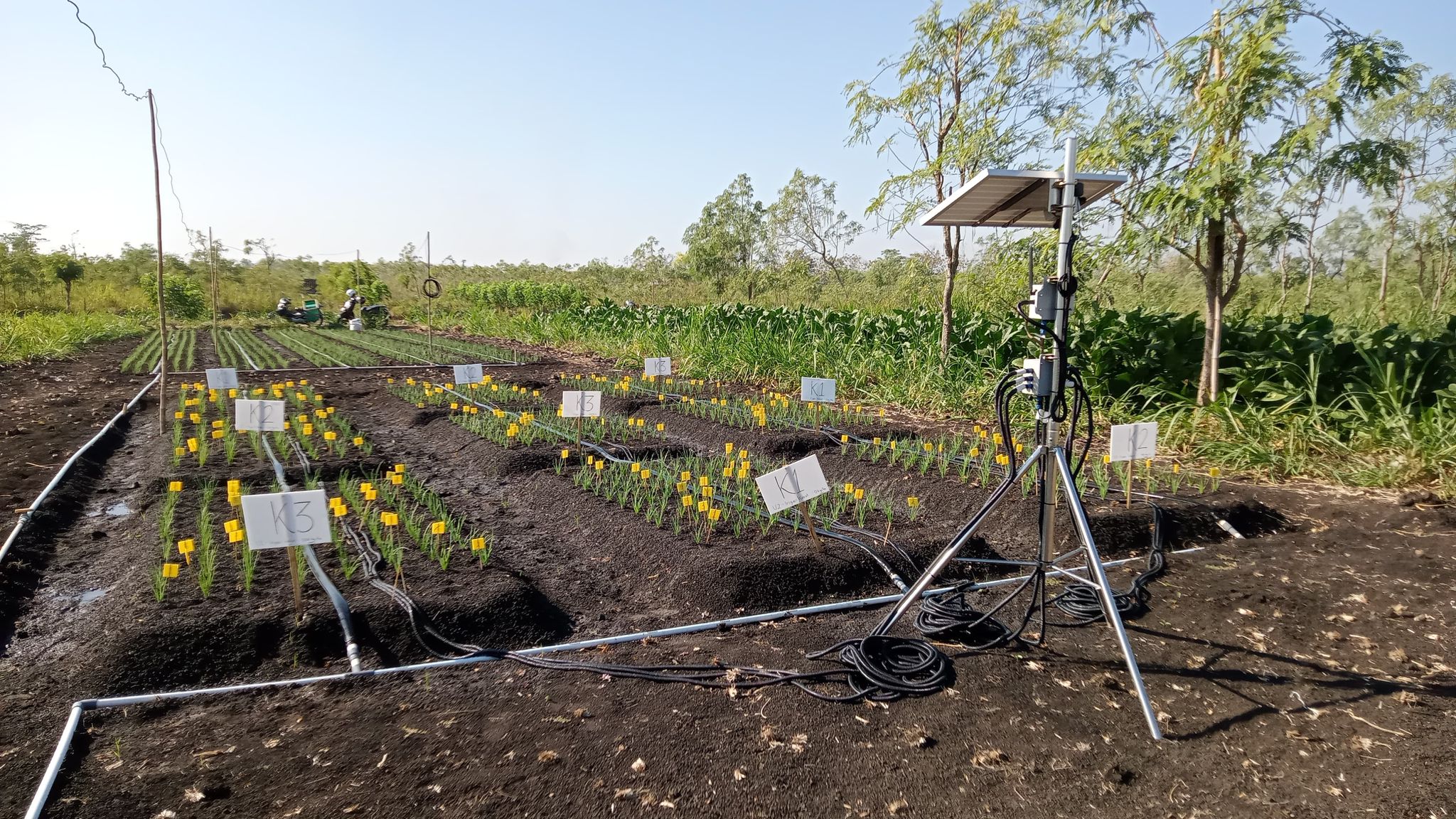Micro Irrigation and NPK Fertilization to Improve Nutrient Uptake and Flavonoid of Shallot in Karst Land
Main Article Content
Fransiska Maria Aprilya Nana
Murtiningrum
Muhamad Khoiru Zaki
Virgolie Diknas Ximenis
Ngadisih
Rizki Maftukhah
Sahidatun Fahima
Background: Water and nutrient limitations in karst soils hinder the optimal growth of shallots, so water and nutrient management is carried out using variations in micro-irrigation and NPK fertilization. Variations in micro-irrigation and NPK fertilization can support the growth and flavonoid content of shallots.
Aims: This study aims to analyze nutrient uptake and total flavonoid production of shallots in karst soils with variations in micro-irrigation and NPK fertilization.
Methods: The research used a Randomized Block Design (RBD) containing two main factors. The first factor was the irrigation technique, consisting drip irrigation (I1) and mist irrigation (I2). The second factor was the NPK fertilizer dosage, consisting three levels: 0 kg/ha (N1), 500 kg/ha (N2), and 1000 kg/ha (N3). The parameters observed included soil moisture, soil NPK availability, plant NPK uptake, total flavonoids, growth, and shallot yield.
Results: The results showed that mist irrigation with an NPK dose of 1000 kg/ha yielded higher results compared to drip irrigation in terms of soil moisture, NPK availability and uptake, growth, and yield. The highest availability of nitrogen, phosphorus, and potassium in mist irrigation with a dose of 1000 kg/ha was 0.36%, 89.20 ppm, and 0.66 me%, respectively. Phosphorus uptake in mist irrigation was higher than in drip irrigation, at 0.81% and 0.89%, respectively. Growth and yield under mist irrigation with an NPK dose of 1000 kg/ha also yielded the best results compared to drip irrigation with an NPK dose of 1000 kg/ha, namely plant height (30.69 and 29.74 cm), number of leaves (27.65 and 25.77 leaves), and bulb diameter (30.07 and 27.02 mm). The highest total flavonoid content was observed in drip irrigation with a 500 kg/ha dose compared to mist irrigation with a 500 kg/ha dose, namely (78.83 and 50.96 mg/kg). Overall, irrigation techniques with varying NPK doses were able to increase nutrient and flavonoid uptake in shallot on karst land.
Amare, G. (2020). Review on Mineral Nutrition of Onion (Allium cepa L). The Open Biotechnology Journal, 14(1), 134–144. https://doi.org/10.2174/1874070702014010134
Atman. (2021). TEKNOLOGI BUDIDAYA BAWANG MERAH ASAL BIJI (Shallot Cultivation Technology from True Shallot Seed). Jurnal Sains Agro, 6 (1), 11 – 21. https://ojs.umb-bungo.ac.id/index.php/saingro/article/view/497
Bansal, G., Mahajan, A., Verma, A., & Bandhu Singh, D. (2021). A review on materialistic approach to drip irrigation system. Materials Today: Proceedings, 46, 10712–10717. https://doi.org/10.1016/j.matpr.2021.01.546
Bhattacharyya, K., Das, T., Ray, K., Dutta, S., Majumdar, K., Pari, A., & Banerjee, H. (2018). Yield of and nutrient-water use by maize exposed to moisture stress and K fertilizers in an inceptisol of West Bengal, India. Agricultural Water Management, 206, 31–41. https://doi.org/10.1016/j.agwat.2018.04.038
Deshpande, V. P., Ahmad, I., & Singh, C. K. (2024). Sustainable Groundwater Management Through Micro Irrigation: A Critical Review on Challenges and Solutions. Journal of Landscape Ecology(Czech Republic), 17(1), 16–34. https://doi.org/10.2478/jlecol-2024-0002
El-Metwally, I. M., & Saudy, H. S. (2021). Interactive Application of Zinc and Herbicides Affects Broad-leaved Weeds, Nutrient Uptake, and Yield in Rice. Journal of Soil Science and Plant Nutrition, 21(1), 238–248. https://doi.org/10.1007/s42729-020-00356-1
Kareem, A., van Wüllen, A. K., Zhang, A., Walckiers, G., Fasth, E., & Melnyk, C. W. (2024). Water availability determines plant regeneration fates. https://doi.org/10.1101/2024.07.30.605771
Kementan. (2017). Pedoman Budidaya. Jakarta : Direktorat Sayuran dan Tanaman Obat. https://hortikultura.pertanian.go.id/wp-content/uploads/2021/03/PEDOMAN-BUDIDAYA-BAMER-2017.pdf
Kothari, D., Lee, W. Do, & Kim, S. K. (2020). Allium flavonols: Health benefits, molecular targets, and bioavailability. In Antioxidants (Vol. 9, Issue 9, pp. 1–35). MDPI. https://doi.org/10.3390/antiox9090888
Kudoyarova, G. R., Dodd, I. C., Veselov, D. S., Rothwell, S. A., & Yu. Veselov, S. (2015). Common and specific responses to availability of mineral nutrients and water. In Journal of Experimental Botany (Vol. 66, Issue 8, pp. 2133–2144). Oxford University Press. https://doi.org/10.1093/jxb/erv017
Kumar, G. A., Kumar, S., Bhardwaj, R., Swapnil, P., Meena, M., Seth, C. S., & Yadav, A. (2023). Recent advancements in multifaceted roles of flavonoids in plant–rhizomicrobiome interactions. In Frontiers in Plant Science (Vol. 14). Frontiers Media SA. https://doi.org/10.3389/fpls.2023.1297706
Li, G., Long, H., Zhang, R., Drohan, P. J., Xu, A., & Niu, L. (2023). Stable Soil Moisture Alleviates Water Stress and Improves Morphogenesis of Tomato Seedlings. Horticulturae, 9(3). https://doi.org/10.3390/horticulturae9030391
Li, Y., & Su, D. (2017). Alfalfa water use and yield under different sprinkler irrigation regimes in North arid regions of China. Sustainability (Switzerland), 9(8). https://doi.org/10.3390/su9081380
Liu, J. H., Yan, Y., Ali, A., Yu, M. F., Xu, Q. J., Shi, P. J., & Chen, L. (2018). Simulation of crop growth, time to maturity and yield by an improved sigmoidal model. Scientific Reports, 8(1). https://doi.org/10.1038/s41598-018-24705-4
Liu, Z., Jiao, X., Zhu, C., Katul, G. G., Ma, J., & Guo, W. (2021). Micro-climatic and crop responses to micro-sprinkler irrigation. Agricultural Water Management, 243. https://doi.org/10.1016/j.agwat.2020.106498
Lopresti, M., Basana, A., Bighiani, P., Triulzi, G., Calegari, G., & Milanesio, M. (2024). Toward a rational approach for polyphenol usage in the shelf-life extension of oenological products. Next Research, 1(1), 100008. https://doi.org/10.1016/j.nexres.2024.100008
Lv, Y., Jiang, Y., Hu, W., Cao, M., & Mao, Y. (2020). A review of the effects of tunnel excavation on the hydrology, ecology, and environment in karst areas: Current status, challenges, and perspectives. In Journal of Hydrology (Vol. 586). Elsevier B.V. https://doi.org/10.1016/j.jhydrol.2020.124891
Mouhamad, R., Alsaede, A. , & Iqbal, M. (2016). Behavior of potassium in soil: a mini review. https://doi.org/10.13140/RG.2.1.4830.7041
Naveena, B., & Babu, G. R. (2021). Evaluation of Moisture Content of Soil at Different Stages of Plant Growth under Different Irrigation Treatments. International Journal of Plant & Soil Science, 1–10. https://doi.org/10.9734/ijpss/2021/v33i730445
Ombódi, A., Lugasi, A., Daood, H. G., Berki, M., & Helyes, L. (2016). Water supply and temperature effects on some nutritive constituents of direct sown onion. Notulae Botanicae Horti Agrobotanici Cluj-Napoca, 44(1), 245–249. https://doi.org/10.15835/nbha44110257
Pal, A., Adhikary, R., Barman, S., & Maitra, S. (2020). Nitrogen transformation and losses in soil: A cost-effective review study for farmer. International Journal of Chemical Studies, 8(3), 2623–2626. https://doi.org/10.22271/chemi.2020.v8.i3al.9609
Papadimitriou, D. M., Daliakopoulos, I. N., Lydakis-Simantiris, N., Cheiladaki, I., Manios, T., & Savvas, D. (2024). Nitrogen source and supply level impact water uptake, yield, and nutrient status of golden thistle in a soilless culture. Scientia Horticulturae, 336. https://doi.org/10.1016/j.scienta.2024.113384
Patil, J. R., Mhatre, K. J., Yadav, K., Yadav, L. S., Srivastava, S., & Nikalje, G. C. (2024). Flavonoids in plant-environment interactions and stress responses. Discover Plants, 1(1). https://doi.org/10.1007/s44372-024-00063-6
Salem, E. M. M., Kenawey, M. K. M., Saudy, H. S., & Mubarak, M. (2022). Influence of Silicon Forms on Nutrients Accumulation and Grain Yield of Wheat Under Water Deficit Conditions. Gesunde Pflanzen, 74(3), 539–548. https://doi.org/10.1007/s10343-022-00629-y
Sansan, O. C., Ezin, V., Ayenan, M. A. T., Chabi, I. B., Adoukonou-Sagbadja, H., Saïdou, A., & Ahanchede, A. (2024). Onion (Allium cepa L.) and Drought: Current Situation and Perspectives. In Scientifica (Vol. 2024). Hindawi Limited. https://doi.org/10.1155/2024/6853932
Shafreen, M., Vishwakarma, K., Shrivastava, N., & Kumar, N. (2021). Physiology and Distribution of Nitrogen in Soils (pp. 3–31). https://doi.org/10.1007/978-3-030-71206-8_1
Zhao Shuai-Xiang, Zhang, W.-F., Jiang, Y.-M., & Fu-Suo, Z. (2017). Factors leading to excessive nitrogen fertilization on apple in the Loess Plateau. 23(2), 484–491. https://doi.org/10.11674/zwyf.16166
Sibly, R. M., & Brown, J. H. (2020). Toward a physiological explanation of juvenile growth curves. Journal of Zoology, 311(4), 286–290. https://doi.org/10.1111/jzo.12770
Srivastava, A. K., Shankar, A., Chandran, A. K. N., Sharma, M., Jung, K. H., Suprasanna, P., & Pandey, G. K. (2020). Emerging concepts of potassium homeostasis in plants. In Journal of Experimental Botany (Vol. 71, Issue 2, pp. 608–619). Oxford University Press. https://doi.org/10.1093/jxb/erz458
Terán-Chaves, C. A., Montejo-Nuñez, L., Cordero-Cordero, C., & Polo-Murcia, S. M. (2023). Water Productivity Indices of Onion (Allium cepa) under Drip Irrigation and Mulching in a Semi-Arid Tropical Region of Colombia. Horticulturae, 9(6). https://doi.org/10.3390/horticulturae9060632
Wang, C., Shen, Y., Fang, X., Xiao, S., Liu, G., Wang, L., Gu, B., Zhou, F., Chen, D., Tian, H., Ciais, P., Zou, J., & Liu, S. (2024). Reducing soil nitrogen losses from fertilizer use in global maize and wheat production. Nature Geoscience, 17(10), 1008–1015. https://doi.org/10.1038/s41561-024-01542-x
Wang, Y., Chen, Y. F., & Wu, W. H. (2021). Potassium and phosphorus transport and signaling in plants. Journal of Integrative Plant Biology, 63(1), 34–52. https://doi.org/10.1111/jipb.13053








